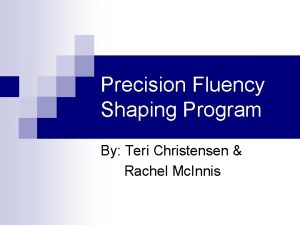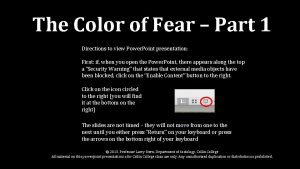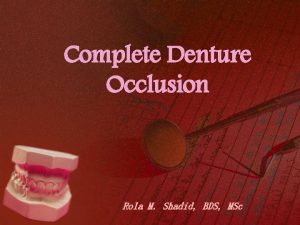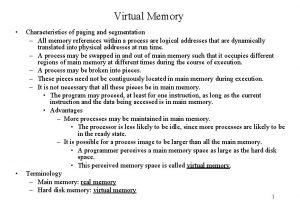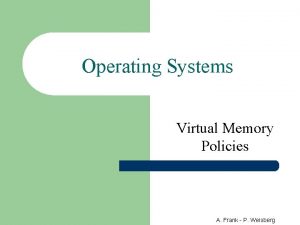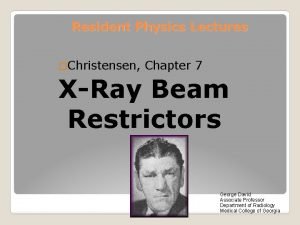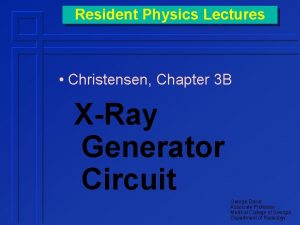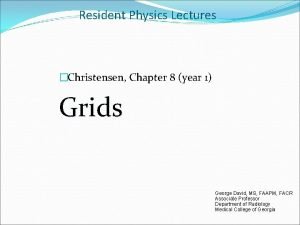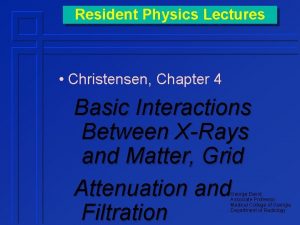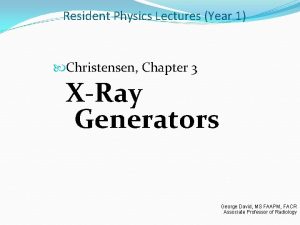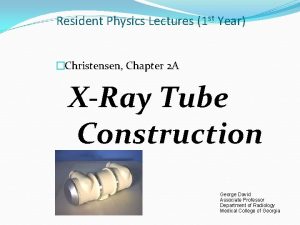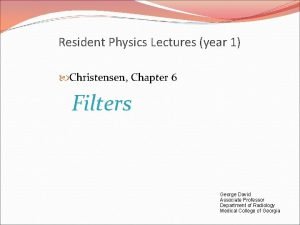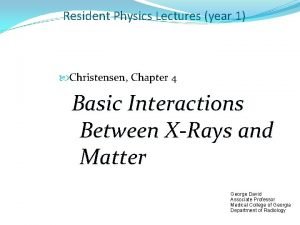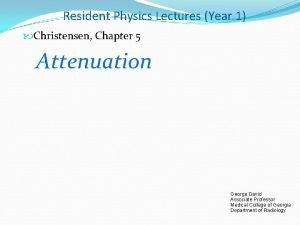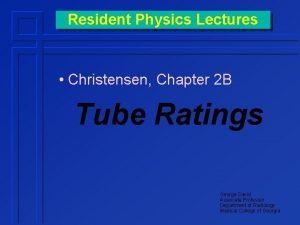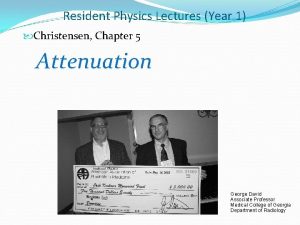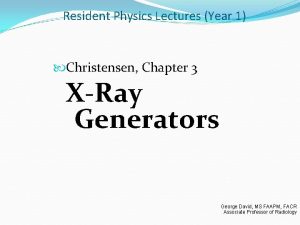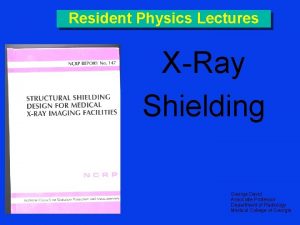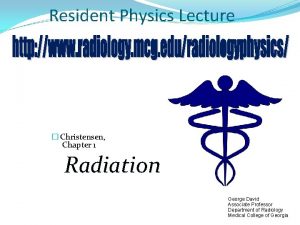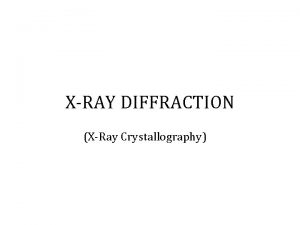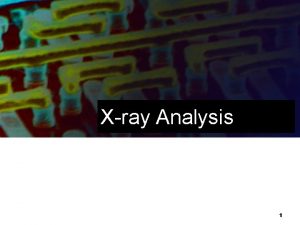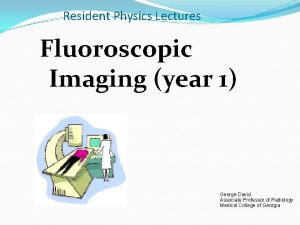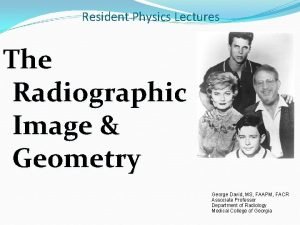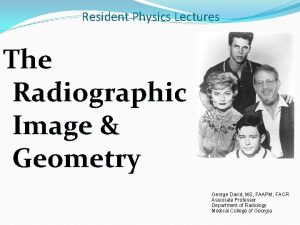Resident Physics Lectures Christensen Chapter 2 A XRay































- Slides: 31

Resident Physics Lectures • Christensen, Chapter 2 A X-Ray Tube Construction George David Associate Professor Department of Radiology Medical College of Georgia

* X-Ray Tube Components • Housing ¨ Visible part of tube • Glass Enclosure (insert) ¨ Vacuum ¨ Electrodes » Cathode • Filament » Anode • Target

X-Ray Tube * • Converts Energy ¨ FROM » electrical energy ¨ To » Heat • > 99% of incident energy • Bad! Ultimately destroys tubes » X-Rays • < 1% of incident energy • Good! Our desired product

* Tube Housing • Shields against leakage radiation ¨ lead lined ¨ leakage limit » 100 m. R / hour when tube operated at maximum continuous current for its maximum rated kilovoltage

Tube Housing (cont. ) • Shields against high voltage ¨ electrically grounded ¨ high voltage cable receptacles (wells) • housing filled with oil ¨ cools ¨ electrical insulation » all air removed ¨ bellows » on end of tube » allows oil to expand when hot. Oil Insert Vacuum

Inside the Glass Insert • Filament ¨ Similar to light bulb ¨ Glows when heated • Target ¨ Large (usually) tungsten block target filament

* X-Ray Tube Principle • Filament heated ¨ electrons gain energy ¨ electrons freed (“boiled” off) ¨ Thermionic emission -

X-Ray Tube Principle * + • Positive (high) voltage applied to anode relative to filament ¨ electrons accelerate toward anode target » Gain kinetic energy ¨ electrons strike target » electrons’ kinetic energy converted to • heat • x-rays

Requirements to Produce X-Rays • Filament Voltage • High Voltage anode + high voltage source filament voltage source

Cathode (filament) • Coil of tungsten wire ¨ similar to light bulb filament • Tungsten advantages ¨ high melting point ¨ little tendency to vaporize ¨ long life expectancy • Tungsten disadvantages ¨ not as efficient at emitting electrons as some other materials

Cathode (filament) • Cathode is source of electrons • filament heated by electric current ¨ ~ 10 volts ¨ ~ 3 -5 amps • filament current is not tube current

Tube Current (m. A) • rate of electron flow from filament to target ¨ Electrons / second • Measured in milliamperes (m. A) + • Limited by ¨ filament emission (temperature / filament current) ¨ space charge (see next slide)

Space Charge * • Electrons leave filament ¨ filament becomes positive » Negative electrons stay close • Electron cloud surrounds filament • Cloud repels new electrons from filament • Limits electron flow from cathode to anode + -

Kilovoltage & Space Charge • raising kilovoltage gradually overcomes space charge + ¨ Higher fraction of electrons make it + + ++ - • At high enough kilovoltage saturation results ¨ All electrons liberated by filament reach target • Raising kilovoltage further has no effect on # electrons reaching anode Tube Current (m. A) to anode as kilovoltage increases Saturation Voltage k. Vp

Saturation Voltage + ++ - • kilovoltage at which a further increase does not increase tube current ¨ 100% of electrons already going to target • Tube current said to be emission limited ¨ tube current can only be increased by increasing filament temperature

Focal Spot • portion of anode struck by electron stream • Focal spot sizes affects and limits resolution +

Focusing Cup • negatively charged • focuses electron stream to target ¨ overcomes tendency of electrons to spread because of mutual repulsion + Focusing Cup

Focal Spots • Most tubes have 2 filaments & thus 2 focal spots • only one used at a time • small focus ¨ improved resolution • large focus ¨ improved heat ratings ¨ Electron beam strikes larger portion of target

Filament (cont. ) • Large Filament normally left on at low “standby” current ¨ boosted before exposure (prep or first trigger) • With time tungsten from hot filament vaporizes on glass insert ¨ thins the filament ¨ filters the x-ray beam ¨ increases possibility of arcing » electrons attracted to glass instead of target +

Cross Section of X-Ray Tube Dunlee Web Site: http: //www. dunlee. com/new_tube_anatomy. html

Cross Section of X-Ray Tube Dunlee Web Site: http: //www. dunlee. com/new_target. html

Line Focus Principle • Focal spot steeply slanted ¨ 7 -15 degrees typical + • Focal spot looks small from patient’s perspective Actual FS Apparent FS ¨ Imaging size • Looks large from filament ¨ better heat capacity Patient

Line Focus Principle • Actual (true) focal spot + ¨ as seen from filament Actual FS • Apparent (effective, projected) focal spot ¨ as seen from tube port or patient Apparent FS Patient

Target Angle ¨Angle between target & perpendicular to tube axis ¨Typically 7 – 15 degrees + Target Angle, Q

Line Focus (cont. ) + Actual FS Apparent FS Target Angle, Q Apparent FS = Actual FS X sin Q

Target Angle (cont. ) • Large • Small – poorer heat ratings – better field coverage ¨ optimizes heat ratings Large Target Angle (Small Actual Focal Spot) Small Target Angle (Large Actual Focal Spot) + ¨ limits field coverage +

Heel Effect • Intensity of x-ray beam significantly reduced on anode side • beam goes through more target material exiting the anode x anode side - - cathode side

Anodes • Stationary • Rotating ¨ Target is annular track ¨ spreads heat over large area of anode ¨ speeds » 3600, 9600 rpm » Faster = much better heat ratings

Rotating Anode • Advantages ¨ better heat ratings • Disadvantages ¨ More complex ($) » Rotor drive circuitry » motor windings in housing » bearings in insert

Rotating Anode • Larger diameter ¨ Better heat ratings ¨ heavier » requires more support ¨ $$$ • Materials ¨ usually tungsten » high melting point » good x-ray production ¨ molybdenum (and now Rhodium) for mammography » low energy characteristic radiation

Grid-controlled tubes • Grid used to switch tube on/off ¨ grid is third electrode ¨ relatively small voltage controls current flow from cathode to anode » Negative grid voltage repels electrons from filament » Grid much closer to filament than target • Applications grid ¨ speedy switching required » cine +
 Yelena bogdan md
Yelena bogdan md Ota resident lectures
Ota resident lectures Frcr physics lectures
Frcr physics lectures Rotating anode
Rotating anode Chapter 2 the nursing assistant and the care team
Chapter 2 the nursing assistant and the care team Anteroposterior compensating curve
Anteroposterior compensating curve Precision fluency shaping program review
Precision fluency shaping program review Martin juul christensen
Martin juul christensen Christensen fenomeni
Christensen fenomeni The color of fear
The color of fear Tommy christensen gu
Tommy christensen gu Balanced occlusion vs balanced articulation
Balanced occlusion vs balanced articulation Gerald barnbaum
Gerald barnbaum Dani christensen
Dani christensen Resident set management
Resident set management Resident retention
Resident retention The working set strategy
The working set strategy Taxpayer identifying number
Taxpayer identifying number Biostats step 3
Biostats step 3 Resident lifecycle
Resident lifecycle Attending vs resident
Attending vs resident Examples of misappropriation of resident property
Examples of misappropriation of resident property If a resident with ad shows violent behavior the na should
If a resident with ad shows violent behavior the na should Positioning transfers and ambulation
Positioning transfers and ambulation Partially resident textures
Partially resident textures Acgme resident survey
Acgme resident survey Employment of non-resident aliens in the philippines
Employment of non-resident aliens in the philippines Telephone 911
Telephone 911 What is conflict resolution in customer service
What is conflict resolution in customer service Define resident flora
Define resident flora Resident subnet
Resident subnet Resident assessment instrument definition
Resident assessment instrument definition






